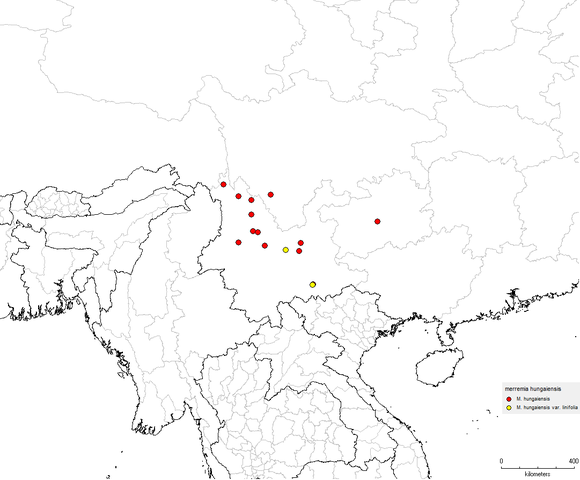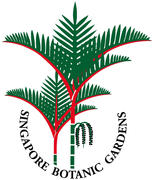Nomenclature
Accepted name/Authority/Place of publication:
Merremia hungaiensis (Lingelsh. & Borza) R. C. Fang, Fl. Reipubl. Popularis Sin. 64(1): 76. 1979.
Description
Habit:
Herbs perennial, twining, with globose or ovoid tubers. Stems striate, glabrous.
Leaves:
Petiole 8–35 mm, pubescent; leaf blade elliptic, ovate, oblong, or narrowly elliptic to linear, 2.5–11.5 cm × (4–)7–50 mm, glabrous, sparsely ciliate only at base, base obtuse, cuneate, or shallowly cordate, margin entire or minutely erose, apex obtuse, emarginate, acuminate, or acute, mucronulate.
Inflorescences:
Inflorescences lax dichasial cymes, 2- to several flowered, rarely flowers solitary; peduncle 2–6 cm, glabrous; bracts scale-like, ca. 1 mm. Pedicel 5–20 mm, thicker than peduncle, glabrous.
Flowers:
Sepals elliptic, unequal, outer 2 sepals 7–14 mm, inner sepals 1.2–1.5 cm, glabrous. Corolla yellow, funnelform, 3.5–6 cm, midpetaline bands pubescent apically. Stamens slightly unequal; filaments pubescent basally. Ovary conical, glabrous.
Fruits:
Capsule oblong, 1–1.3 cm.
Seeds:
Seeds 5.5–7 mm, densely dark brown tomentose.
References:
Fang R.C., G. Staples, et al. 1995. Convolvulaceae in P. Raven & C.Y. Wu (eds.) Flora of China 16: 271–325.
Biogeography, Ecology and Natural History
Distribution Map:

Distribution:
China (Guizhou, Sichuan, Yunnan). Endemic.
Ecology:
Grassy, shrubby
mountain slopes, pine forest floors, roadsides, thickets; 1200–3200 m.
References:
Fang R.C., G. Staples, et al. 1995. Convolvulaceae in P. Raven & C.Y. Wu (eds.) Flora of China 16: 271–325.
Other information
Common names and uses:
shan tu gua (Chinese).
The roots are used externally to treat scabies.
Infraspecific Characters:
Chinese floras recognize 2 varieties, separable by the following key:
1a. Leaf blade elliptic, ovate, or oblong, 2.5–11.5 cm × 12–50 mm var. hungaiensis
1b. Leaf blade narrowly elliptic to linear, 5–10 cm × 4–15(--30) mm var. linifolia
Authorship for webpage
Editor:
George Staples, Esmond Er
Contributors:

Classification:

Add new comment